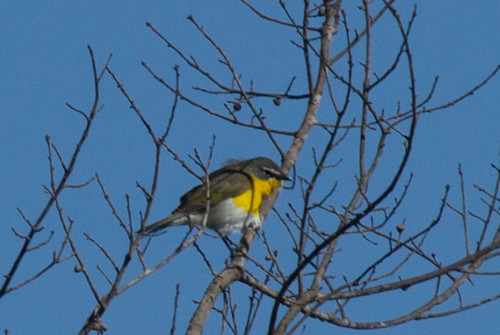I’m in Maine right now. Friday night I was the keynote speaker at the LL Bean/Maine Audubon Birding Festival and have been helping with field trips for that, and next weekend I’ll be helping with field trips at the Acadia Birding Festival. I’ve run into quite a few people who come to both festivals, taking the opportunity while they’re in Maine to see as many birds as possible. The only birding I’d done in southern Maine before this has been at Popham Beach State Park, which I haven’t visited so far this time, but I’ve already added 19 species to my Maine list without spending time on the coast yet.
Except for the coast, which is populated with puffins, razorbills, and other ocean species, Maine seems a lot like northern Minnesota, and shares a lot of our birdlife. So I never expect to see anything out of the ordinary inland. But on Friday morning when I was birding with Laurie Gilman of Maine Audubon, we came upon something unexpected in a little birding spot in Freeport: a Yellow-breasted Chat, singing away.
I saw lots of chats during my Big Year, mostly in Delaware where they belong—their population is densest in the Southeast, most especially in Arkansas, Louisiana, Mississippi, and Alabama, and they range north to Pennsylvania across to south-central Wisconsin; they also breed throughout the American West where they find suitable scrubby habitat.
Individuals sometimes overshoot during migration, and that’s presumably what happened to this guy. The habitat looked good, and as long as he was in Maine, I guess he figured he’d stake out a piece of property. I doubt if any males were anywhere near to dispute his claim. If a female overshot her own migration route and was anywhere near, this guy’s singing would certainly have been a welcome sound, but as far as we could tell, he was the only chat anywhere around. When I first heard him, I didn’t even realize what he was—he didn’t sound like a catbird, thrasher, or mockingbird, and I was mainly considering what I thought were likely suspects. I recorded him without knowing who he was until suddenly he flew from one perch to another and I got a brief but clear look.
Many birders feel offended when they submit a bird list and an eBird reviewer asks for documentation. But in order to keep accurate records of rare birds, it’s important to ensure that those birds really were what the birder thought they were. This weekend a Kirtland’s Warbler was reported in Duluth by John Richardson. In eBird, he noted:
Brief but good looks by the beach house. Decent sized Warbler. First thought was female MAWA, but the bobbing tail was very distinctive warranting further investigation. Noticeable feature included the two thin white wing bars, thin black streaking on the sides. When it flew there was a uniform dark from head to tail. No yellow on the rump eliminating MAWA. Also, the only white on the tail was restricted to the outer tail feathers at the end. MAWA should have had white in the mid-section of the tail. Eye ring was broken with white at the top and bottom of the eye.That account gave every one of the salient identifying characteristics of Kirtland’s Warbler and clearly eliminated the possibility that it could have been the species most easily confused with it. I'm really sad that I was out of town to miss such a great bird. My Yellow-breasted Chat was not nearly as much an outlier here in southern Maine as the Kirtland’s Warbler was in Duluth, but it still required documentation. I was lucky—not only did I get a clear look, but my recording of the unmistakable song was compelling proof.
Until 2017, the Yellow-breasted Chat belonged to the same family as Kirtland’s—Parulidae, or the Wood Warbler family, but taxonomists were never comfortable about that. It’s much larger than warblers, its song is far more robust and filled with mimicry, its beak is heavier, and its natural history different. The problem is that the chat shares even fewer characteristics with any other family, either. So in 2017, ornithologists placed it in its very own family, created just for it, Icteriidae. They’ve yet to tease out how the species came to be, much as I’ve yet to figure out what my chat was doing in Freeport, Maine. But bird mysteries are fun to think about, and whatever the answers, we’ve got beautiful Yellow-breasted Chats and their funky songs to fill us with as much wonder as questions.
